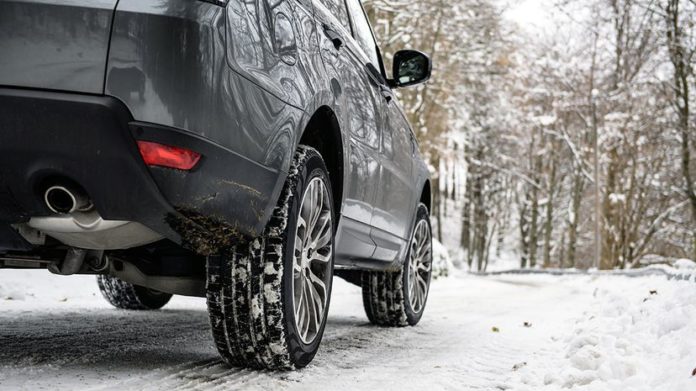\”

Andy and Mercedes Lilienthal, founders of the Subcompact Culture and Crankshaft Culture blogs, grew up in the Midwest, a "darn-near arctic environment," as Andy calls it, and never used snow tires. But in 2003, Andy bought a set of wheels that came with winter tires mounted on them. The first time he drove in the snow with winter tires, he says, "I was amazed at how much better they were — traction, handling, braking, everything."
But don\’t get winter tires confused with studded snow tires. Winter tires don\’t have the metal studs protruding from the tread that can sometimes provide traction in icy conditions. Instead, they\’re made of specialized rubber compounds with particular tread patterns that provide better traction in more types of cold-weather conditions.
What Makes Winter Tires Different?
The rubber used in winter tires needs cold temperatures to work at their best. According to Ron Margadonna, an engineer at Michelin Automotive Tires, that rubber used gets to the very molecular core of tire engineering. Most manufacturers also use silica in the compound for winter tires because it helps the rubber remain flexible (instead of hardening) when temperatures drop below freezing — or even below zero.
The tread design of winter tires, Margadonna says, features deep patterns so the tires can get traction in snow. The pattern has more grooves and cuts in the tread, known as sipes. And the tread blocks in the pattern are smaller so there are more edges to bite into the snow and ice. "All of these are traction aids," Margadonna says.
The channels in winter tires are often wider, and there are more of them than in all-season tires. More channels means even more edges that can grip snowy streets. Wider channels also means they can clear out snow and slush from the tread more quickly instead of becoming packed full, which reduces traction.
Who Needs Winter Tires?
If you post pictures of yourself outside wearing your one warm sweater on the one day a year that snow flurries fall in your neighborhood, you probably don\’t need winter tires. All-season tires will provide enough stopping power for you.
But if you live in an area that sees regular snowfall or icy conditions, then winter tires will provide the extra traction you\’ll need for daily driving. Tire manufacturers often cite 45 degrees Fahrenheit (7 degrees Celsius) as a benchmark. If your winters are, on average, below that, then snow tires will likely help. Experts recommend installing a full set of four winter tires to reduce the chance of skidding when the weather turns.
Winter tires are engineered for cold temperatures, but it\’s not the end of the world if you don\’t swap them out for all-season tires when weather warms. It isn\’t necessarily great either, though. Because winter tires use a softer rubber compound than standard tires, running them every day on dry pavement will wear them out faster, Margadonna says. And they don\’t provide optimum traction on warm, dry roads.
Of course, if you do use both winter and summer tires, you have to store the extra set when it\’s not in use. The Lilienthals simply store their sets of off-season tires for their four vehicles in a crawl space under their house.
Margadonna says a lot of people assume that if they have all-wheel drive or four-wheel drive, they don\’t need winter tires. "Those systems are only as good as the tires on the vehicle," he warns. While sending power to all four wheels does increase a vehicle\’s abilities in bad weather, it\’s the tires that give the car better starting traction, braking and cornering capabilities.
How to Tell If It\’s a Winter Tire
Telling winter tires from all-season tires is easy. Just look for the mountain and snowflake icon on the sidewall of the tire — the part easily visible when you stand next to the tire — then it\’s a winter tire. "We call it the \’mountain peaks and snowflake marking,\’" Margadonna says. That symbol means it\’s passed traction tests on snow conducted by the U.S. Tire Manufacturers Association.


Just remember: Winter tires are not studded tires. In fact, many states have banned studded tires outright. Those little metal studs tear up paved roads when there isn\’t snow covering them. Margadonna points out that while studded tires can be somewhat beneficial on ice, "they offer no enhancement on snow." And they aren\’t even that great on ice. The studs can grip soft ice, but when ice becomes hard and brittle, they have less traction. Michelin doesn\’t even sell studded tires. "Studless tires can do what studded tires do and more," Margadonna says.
Mercedes Lilienthal agrees. "Studded tires are not the best practice," she says, while admitting that the Lilienthals do have and sometimes use studded tires. In many parts of the country, the roads aren\’t constantly covered with soft ice. There are many days when the roads are clear, and "studs are worse for braking in rainy or dry conditions," she says. "If you have to stop in a pinch with studded tires on a dry road, you\’re in a world of hurt."
Now That\’s Interesting
Some western states require winter-rated tires or traction devices, such as chains, on mountain passes. Margadonna advises checking with the state department of transportation to see if winter tires work as a "get out of jail free card" so you don\’t have to stop and kneel in the snow to chain up.
Originally Published: Jan 17, 2018
Winter Tires FAQ
Can you use winter tires all year round?
You don\’t want to use your winter tires all year long. Winter tires are made of different materials, like specially engineered rubber that can withstand freezing temperatures. And if you use them in warmer weather, you\’ll notice adverse effects like worse handling or compromised responsiveness, increased wear, and even damage as winter tires are designed for lower speeds notes Firestone.
Are winter tires better than all season?
Winter tires tend to perform better in winter weather and road conditions because of their specialized design. These tires tend to have winter-specific features, like deeper tread and increased traction, uniquely formulated rubber that won\’t freeze or crack, and even metal studs for the ultimate grip.
What temperature is too warm for winter tires?
Once the daily temperature stays around 45 degrees Fahrenheit or higher consistently, it\’s time to switch your winter tires for warmer-weather ones.
How do I know what size winter tires to get?
You can determine the right tire size for your vehicle by either looking at the sidewall of your standard tires or the printed sticker placed on the inside frame of your driver\’s side door.
Are bigger or smaller tires better in the snow?
While you might assume bigger is better in snowy conditions, smaller tires can actually offer you more stability. The key is traction — no matter the size of your tires, you want to have deep tread that can push away snow while your tires spin.












